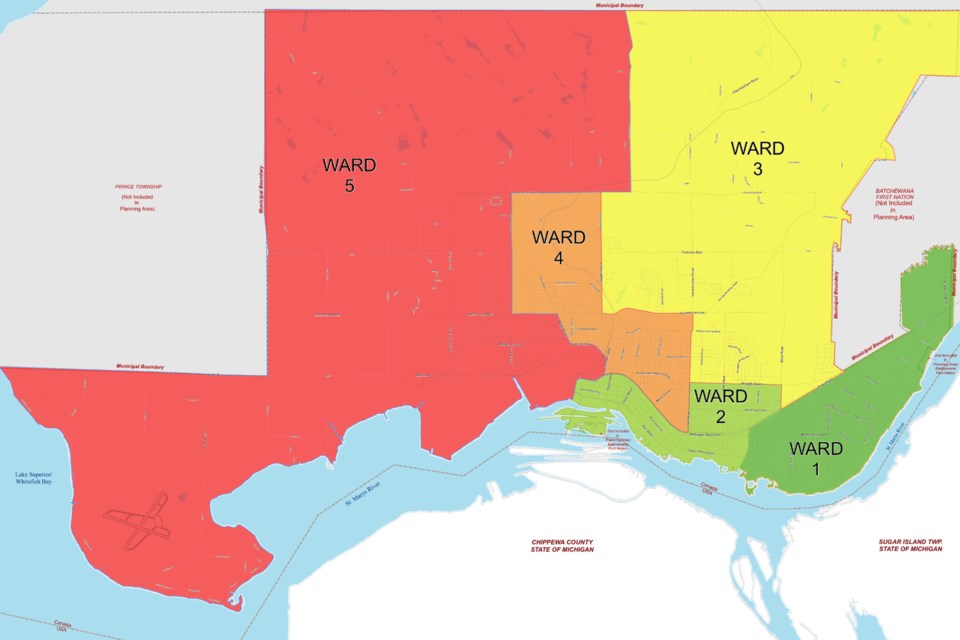Here it is, political junkies!
Here's the redrawn ward boundary map intended to reduce the Sault's 12-councillor, six-ward electoral system to 10 councillors and five wards.
City Council agreed on March 6 to redraft our council representation/ ward boundary map to move to a five-ward system.
This draft map will be presented to City Council on Monday night.
The proposed ward populations are as follows:
- Ward 1 - 16,886
- Ward 2 - 13,881
- Ward 3 - 14,507
- Ward 4 - 16,095
- Ward 5 - 11,999
Councillors are expected to receive the new ward map as information, and to authorize two open houses at the Civic Centre to get additional community input.
A bylaw recommending council composition and ward boundaries will then be presented at the August 21 council meeting, possibly including changes to the ward map based on public consultations.
The following are excerpts from a report to City Council prepared by Malcolm White, city clerk and deputy chief administrative officer:
Representation by population
Ideally, population in all five wards would be equal; however a variance of up to 25 per cent has been deemed acceptable when balanced against other principles.
While the proposed new Ward 5 would have a lesser population, this is offset by the significantly larger geographical area it occupies.
Proposed ward boundaries duplicate census subdivisions, giving ward councillors insights into demographics, income, housing type, ethnicity and other census data pertaining to their constituents.
Communities of interest and neighbourhoods
Proposed ward boundaries are respectful of historical neighbourhoods and communities of interest. There are very few examples of historical neighbourhoods being bisected by the boundaries. As well, the focal areas of current development (Downtown area – Ward 2, Great Northern Road corridor – Ward 3) are now encompassed within one ward.
Present and future population trends
The proposed Wards 1, 2 and 4 are fairly densely populated, while Wards 3 and 5 (as proposed) have lower population density and potential for future development.
The population levels in all proposed wards should remain within the acceptable variance ratios for the near- to medium-term.
Physical features as natural boundaries
Using natural and man-made features that already serve as physical boundaries helps to ensure a coherent, contiguous shape that is straightforward.
The proposed boundaries follow arterial routes and physical boundaries such as rail lines.
The principle of effective representation
The principle of effective representation was set out by the Supreme Court of Canada in Reference Re Provincial Electoral Boundaries (Saskatchewan), [1991] 2 S.C.R. 158 (Carter), the leading authority for evaluating electoral systems in Canada.
The issue in Carter was whether a difference in population between provincial ridings in Saskatchewan infringed the right to vote protected by Section 3 of the Canadian Charter of Rights and Freedoms.
In Carter, the Supreme Court held that the purpose of the right to vote enshrined in the charter is not “equality of voting power” but the right to “effective representation.”
Effective representative is the right to be “represented in government,” where “representation” entails both the right to a voice in the deliberations of government (the legislative role of elected representatives) and the right to bring your concerns to your representative (the ombudsman role of elected representatives).
Effective representation begins with voter parity, the idea that all votes should have equal weight and, as a result, the number of people living in each ward should be similar.
According to the Supreme Court: “A system which dilutes one citizen's vote unduly as compared with another citizen's vote runs the risk of providing inadequate representation to the citizen whose vote is diluted. The legislative power of the citizen whose vote is diluted will be reduced, as may be access to and assistance from his or her representative. The result will be uneven and unfair representation.”
The Supreme Court held that while parity is of “prime importance” it is “not the only factor to be taken into account in ensuring effective representation.”
Notwithstanding the fact that the value of a citizen's vote should not be unduly diluted, effective representation often cannot be achieved without taking other factors into consideration in achieving a balance.
A ward boundary bylaw may be appealed to the Ontario Municipal Board by the province's minister of municipal affairs or any other person or agency within 45 days of the bylaw's adoption.
Appeals must be finalized by December 31 if the boundaries are to be in place in time for the 2018 municipal election.
Monday's City Council meeting will be livestreamed on SooToday starting at 4:30 p.m.
